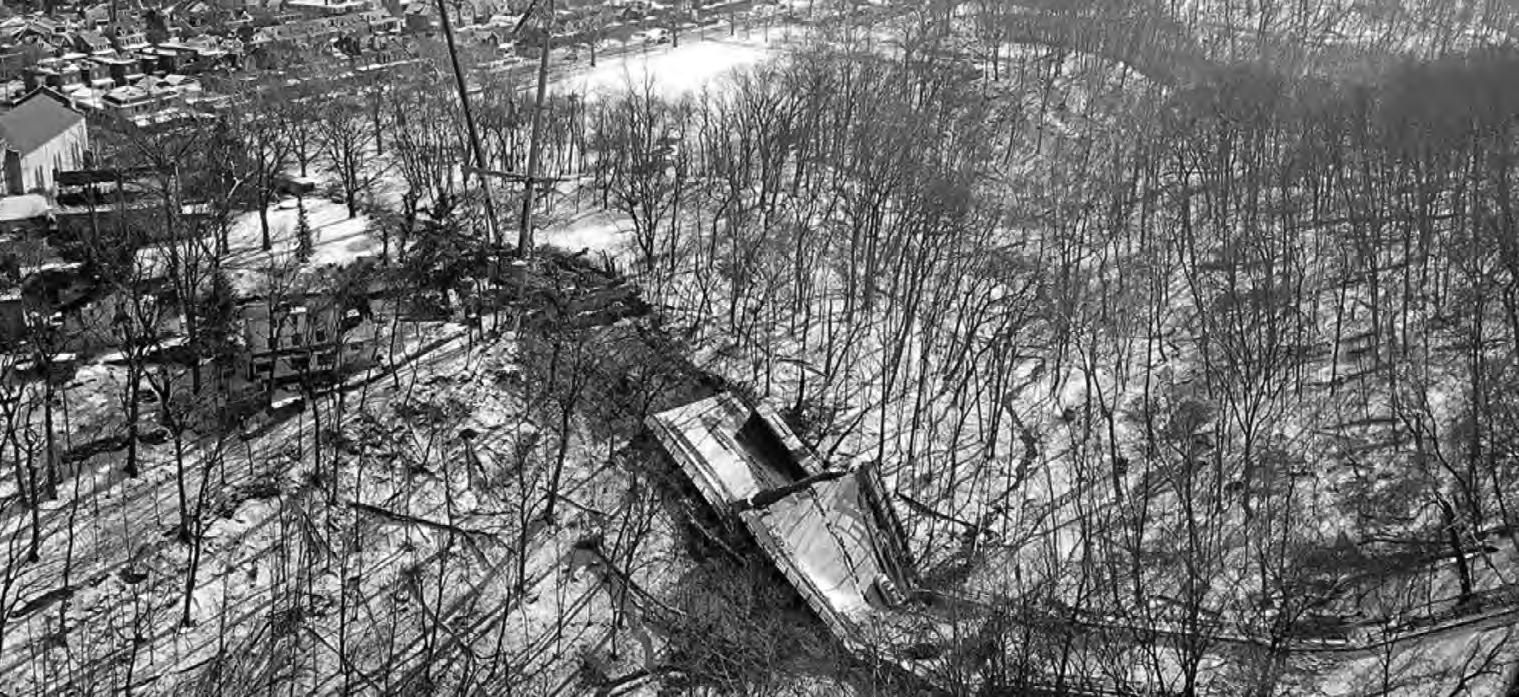
4 minute read
FEDERAL GRANT ALLOWS PENNDOT TO REPLACE COLLAPSED BRIDGE

The wrecked structure spans a ravine in the city’s Frick Park and carried traffic on Forbes Avenue.
Pittsburgh Public Safety photo
A $25.3 million grant from the federal government to the Pennsylvania Department of Transportation (PennDOT)has allowed the state agency to begin preliminary work on replacing the Fern Hollow Bridge in Pittsburgh that collapsed Jan. 29.
The Federal Highway Administration (FHA) notified the state that the rebuilding project was awarded the funds through the National Highway Performance Program. That initiative, which is used to pay for special projects, received millions of dollars in extra money through the bipartisan infrastructure bill President Biden signed into law in November.
The 497-ft.-long bridge collapsed from Forbes Avenue in Point Breeze into a ravine underneath it in the city’s Frick Park, injuring 10 people.
The bridge is a particularly important connection between Pittsburgh’s Point Breeze and Squirrel Hill neighborhoods, and, before the pandemic, carried approximately 14,000 vehicles a day.
Even with the federal money, though, PennDOT officials told the Post-Gazette, that it is too soon to predict how long it will take to build the new structure.
That is because supply-chain problems have made steel beams and other construction supplies difficult to obtain, Cheryl Moon-Sirianni, PennDOT’s district executive, said in an interview with the Pittsburgh newspaper.
Run-Up to Replacement Should Be Quick
One of the first steps, which she noted should happen quickly, is to find private firms to make up a design-build team that will work together on all aspects of the replacement project. That arrangement, she explained, coupled with emergency declarations by the state and city that will allow the project to be built without following normal bidding procedures, should speed up the process because some aspects of the work can move to construction while other elements are still being designed.
In ordinary circumstances, a project is fully designed and put out for bids as a complete package before any work begins.
She added that she does not expect the new bridge to cost much, and any money not spent on the structure could be used for other projects.
Although the Fern Hollow Bridge is owned by the city, PennDOT will oversee the replacement because it has more experience with emergency construction. The agency plans to work collaboratively with city officials throughout the project.
Jason Zang, an assistant district executive who oversees construction for PennDOT, along with his colleague, Shane Szalankiewicz, a district bridge engineer, said agency officials have not decided what type of design the new bridge will follow. That will depend on several factors, including time of construction, which type of beams are most available, the cost, and the impact on Frick Park.
Procuring construction supplies, though, have become a particular problem, MoonSiriani said.
She told the Post-Gazette that she does not expect this to happen, but there could be some attempt to slow down other projects so supplies are available to keep the Fern Hollow bridge rebuild moving if materials become scarce. Board (NTSB) investigators finish their work examining the rubble. Following that, he explained, removal of debris and demolition of the remainder of the bridge will have to be completed — likely while winter weather continues.
PennDOT’s Szalankiewicz said the project faces several challenges, such as working around the park, fitting equipment in the tight space above the ravine and staging construction to minimize disruption to the residents who live on the Point Breeze end of the bridge. Much of the work likely will be limited to daytime hours, he added.
Moon-Sirianni said the emergency project should not interfere with PennDOT’s regular construction schedule this year, which often includes more than $100 million in new and continuing projects in Allegheny, Beaver and Lawrence counties.
The collapse of the decades old four-lane bridge came after it had been rated in “poor” condition for at least 10 years because of deck and superstructure deterioration. NTSB investigators say finding the cause could take as long as 18 months.












